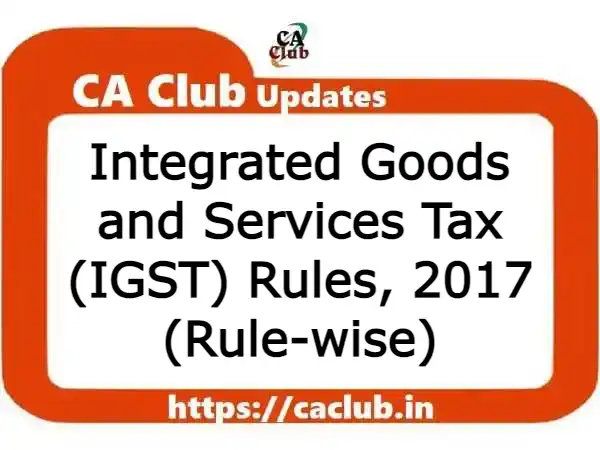Integrated Goods and Services Tax (IGST) Rules, 2017 have been notified by Govt. on 28/06/2017 (effective as of 22/06/2017) followed with various amendment notifications issued by Govt./CBIC from time to time (i.e. 2017 onwards).
Rule-wise Index of the Integrated Goods and Services Tax (IGST) Rules, 2017, relating to provisions for levy and collection of tax on inter-State supply of goods and services (i.e. for carrying out the provisions specified in section 20 of the IGST Act, 2017) as notified/ amended by Govt. of India & CBIC from time to time:
| IGST Rule/ Particulars |
| In exercise of the powers conferred by section 22 of the Integrated Goods and Services Tax Act, 2017 (13 of 2017) read with section 20 of the said Act, the Central Government hereby makes the following rules, namely : |
| Rule 1: Short Title and Commencement |
| Rule 2: Application of CGST Rules |
| Rule 3: Apportionment of IGST on Advertisement Services |
| Rule 4: Supply of Services Attributable to Different States or UTs |
| Rule 5: Place of Supply of Services Attributable to Different States or UTs |
| Rule 6: Place of Supply (Leased Circuit) |
| Rule 7: Place of Supply and Value of Services |
| Rule 8: Proportion of Value of Certain Services Attributable to Different States/ UTs |
| Rule 9: Proportion of Value of Services in Specific Cases |
—–
| IGST Rules, 2017: Last Updated 30/11/2023 |
| The Integrated Goods and Services Tax (IGST) Rules 2017 were initially notified by CBEC vide Integrated Tax Notification 4/2017 dated 28/06/2017 (Rule 1 & 2). Subsequently, IGST Rule 3 has been inserted vide Notification 12/2017 and IGST Rules 4 to 9 have been inserted vide Notification 4/2018. Information on this page is a Rule-wise compilation of Amendments made in CGST Rules, 2017 by various Notifications/Orders issued by CBIC from time to time, with best possible efforts for accuracy. In any case, E&OE. For official/ updated information, please visit CBIC website. |
| Latest Updates from CBIC |
| For index of GST Circulars, Notifications, Press Releases, Orders, etc. issued by CBIC from 2017 and onwards along with Section-wise/Rule-wise Text of GST Acts/Rules: GST Updates |
